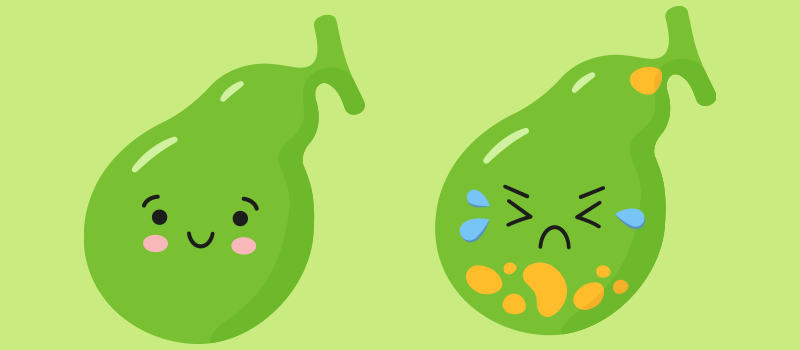What’s the Buzz
The Bee Healthy Blog
Gallstones: Pigment Gallstones vs. Cholesterol Gallstones

Gallstones are a very common condition and affect some 25 million Americans. Approximately 1 million people in the US are diagnosed with gallstones every year, and 1 in 4 need surgical treatment for gallbladder removal. Please continue reading to learn more about gallstone disease, specifically the difference between pigment gallstones and cholesterol gallstones.
Why do gallstones form?
Gallstones are small, hardened collections of cholesterol, bilirubin, and bile salts that develop in the gallbladder and bile ducts. They can vary in size from tiny stones that are as small as a pinhead or grain of sand to as large stones that are as big as a lemon or golf ball. A person can have many tiny gallstones, one very big gallstone, or a combination of different-sized stones.
Most gallstones are “silent,” meaning the gallbladder stores the stones, but they don’t cause any symptoms or require any treatment. But sometimes, gallstones block the biliary system, specifically the bile ducts. These ducts empty bile from the gallbladder into the small intestine. A blockage in the bile ducts can lead to sudden and severe pain in the right upper belly. This is known as a gallbladder attack (medical term: biliary colic). The symptoms of a gallbladder attack can be debilitating.
Without treatment, gallbladder disease can lead to serious complications such as cholecystitis (inflammation of the gallbladder), blockage of the bile ducts, and an increased risk of gallbladder cancer.
What are the two different types of gallstones?
There are two principal types of stones—cholesterol stones and pigment stones.
- Cholesterol gallstones are the more common type of gallstones. Indeed, chemical analysis shows that cholesterol gallstone formation accounts for approximately 75 percent of gallstones in some parts of the world. Cholesterol stones form due to cholesterol supersaturation (high cholesterol content in the bile). They consist of undissolved and hardened cholesterol plus other substances like calcium carbonate. A cholesterol stone is typically yellow-green in color.
- Pigment gallstone formation is less common, and pigment stones account for fewer cases of gallstone disease. These gallstones can be brown pigment stones or black pigment stones. Pigmented gallstones are made of bilirubin and form when the gallbladder bile contains too much conjugated bilirubin or unconjugated bilirubin.
Note that a person can have mixed cholesterol and pigment gallstones. Doctors can use blood tests and procedures like endoscopic retrograde cholangiopancreatography (ERCP) to diagnose and treat gallstones. However, a chemical analysis is required to find out whether the gallstones are cholesterol stones, brown or black pigment gallstones, or mixed stones.
Are gallstones made from cholesterol?
The chemical composition of gallstones can be cholesterol. This can occur if the gallbladder bile contains too much cholesterol. In healthy individuals, the liver secretes cholesterol into human bile, and the bile contains chemicals that dissolve the cholesterol. But if the liver secretes more cholesterol than the bile can dissolve, the extra cholesterol can form into cholesterol gallstones.
What are pigment gallstones?
Pigmented stones are predominantly composed of extra bilirubin in the bile. Bilirubin is a substance that is formed when the liver breaks down red blood cells. In some health conditions, such as biliary tract infections, certain blood disorders, and liver cirrhosis, the liver makes too much bilirubin. The extra bilirubin can combine with calcium salts and form a pigment gallstone, such as a calcium bilirubinate gallstone.
Who is at risk of pigment gallstones or cholesterol gallstones?
Certain people are at higher risk of developing gallstones, including cholesterol stones, pigmented stones, and mixed stones. Risk factors for gallstones include:
- Gender: Women are at a greater risk of forming gallstones compared to men. Moreover, women who take hormone replacement therapy or oral contraceptives (birth control pills) and have extra estrogen in the body are at higher risk.
- Age: Age plays a role in gallstone pathogenesis. Older individuals are at greater risk of forming cholesterol, pigmented, or mixed gallstones.
- Race: American-Indians and Mexican-Americans have some of the highest rates of stone formation in the US.
- Family History of Gallstones: Genetic factors play a role in the formation of gallstones. Having a first-degree family member with gallstones is associated with a higher risk of gallstones.
- Lifestyle Factors: Being overweight or obese, leading a sedentary lifestyle, and eating a high-fat, high-cholesterol, and low-fiber diet are other risk factors for gallstone formation.
- Alcohol Consumption: Heavy alcohol consumption can increase the risk of gallstones, but moderate alcohol consumption may actually reduce the risk.
- Health Conditions: Pregnant women, diabetic patients, bariatric patients and people with liver disease and blood disorders like leukemia and sickle cell anemia are at higher risk of developing gallstones.
How to prevent gallstones?
Some risk factors for gallstones are not in your control, such as age, gender, and race. However, you can reduce your risk of gallstones by:
- Maintaining a healthy body weight. Obesity is a risk factor for gallstones.
- Losing weight slowly. Rapid weight loss is associated with an increased risk of gallstones. Losing 1-2 pounds (0.5 to 1 kg) a week is healthy.
- Not skipping meals. Fasting or skipping meals can increase your risk of gallstones.
- Eating a healthy diet. High-fiber foods can lower your risk of gallstones.
References:




SOCIAL